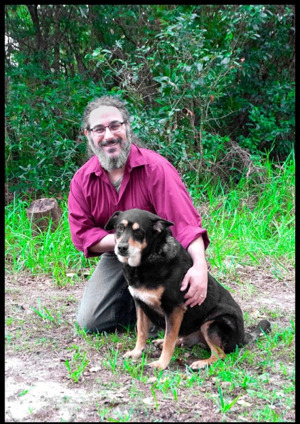Thanks for your support! If you make a purchase using our links in this article, we may make a commission. And, as an Amazon Associate, I earn from qualifying purchases. See the full disclosure here.
Memorializing a pet with a DIY RV cabinet is a great solution to continue the journey with your pet. After the two-legged kids have moved on to start their lives, you’ll always have your pet’s urn in a glass-front DIY RV cabinet with you. You may have a new pet filling an empty space, but you can always look to the DIY RV cabinet pet memorial to remember the good times.
If you travel with your pet, like our editor Brian Newman and his wife Marianne, their dogs are truly special to them. Unfortunately, they had to make the hard call on February 11, 2021, letting their Dutch Shepherd, Anubis Ra, cross the Rainbow Bridge due to cancer.
The Newmans don’t use the TV above the driver’s area in their 2001 Fleetwood Pace Arrow, so they removed it. At first, they weren’t sure what they wanted to do with the freed-up RV TV cabinet, but they didn’t want to let it go to waste. Once Anubis was at peace, Brian knew exactly what to do with it: build a DIY RV cabinet to memorialize Anubis and other pets that passed on.
Some of our RV Camping for Newbies Facebook page friends have asked about DIY RV cabinet ideas. Brian walks us through how he repurposed his RV TV cabinet to honor Anubis with his DIY RV cabinet pet memorial.
DIY RV Cabinet Remodel to Memorialize Our Dog Anubis Ra
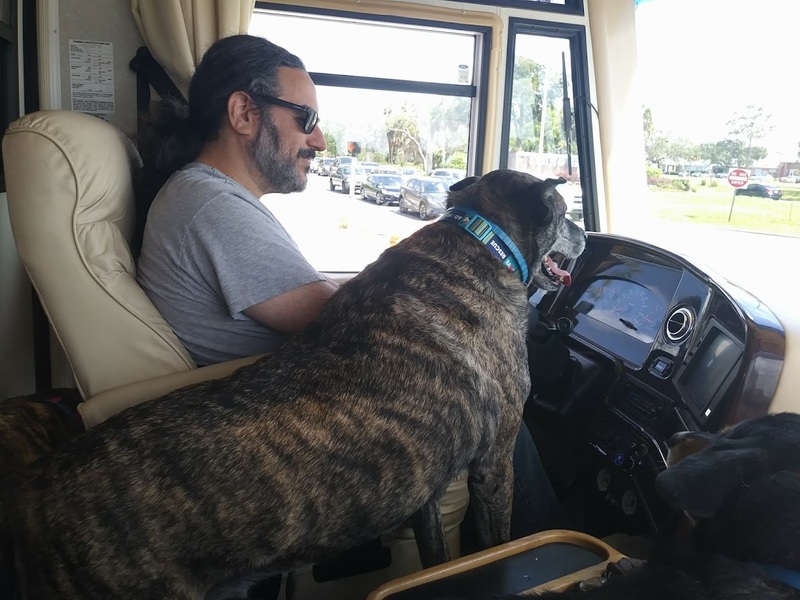
Our decision to memorialize Anubis with a DIY RV cabinet remodel came to me as soon as we returned from the vet. It was like all the puzzle pieces coming together all at once. Even though this was the first RV remodel I’d ever attempted, there wasn’t a “fear of the unknown” feeling. Instead, it was as if this was the natural course I should take.
Anubis loved to travel. We tried everything to get him to lay down while we were driving. There was too much to bark at and see. Keisha, our Whippet mix, always lays under Marianne’s feet in the co-pilot area because she’s not a fan of her house moving. Our Rottweiller/Beagle mix, Akiva (nicknamed the “Rottenest of Bagels”), lays on the sofa behind the driver or in the center aisle behind his big brother. Anubis had to see it all until he was too tired to stand.
Anubis Ra, or “Nubie Du,” developed lung cancer at 13 years old. Marianne and I had been around disease most of our lives through various relatives. Instead of putting him through chemotherapy trials, we agreed to a palliative treatment plan after a long conversation with our vet.
After three weeks, the cancer was obstructing his breathing to dangerous levels. The best choice was to let Nubie Du cross the Rainbow Bridge to the “Great Field in the Sky.” Our vet and the entire staff were unbelievably great for him and us. Even the other pet parents there gave us their sympathies. We are relatively new to the vet’s practice, and every experience has been the best.
When Mari and I returned home from the vet’s office, that’s when the emptiness fully hit us. His dog bed was still in front of the sofa, so he was always the first thing you saw when you walked in. I then looked to the driver’s area and saw the empty overhead TV cabinet. I’ve wanted to do something with the space, but now I knew what I had to do.
I would turn the overhead front TV cabinet into a memorial space for Anubis and our other dogs that passed on. The DIY RV cabinet could display their urns and a photo of my parent’s basset hound. I could add new interior walls using plywood to cover the unfinished sides, bottom, and top. A couple coats of matching wood stain would make the DIY RV cabinet fit in with the motorhome’s wood features like it was meant to be there. I would also add some ambient LED lights to enhance the space at night.
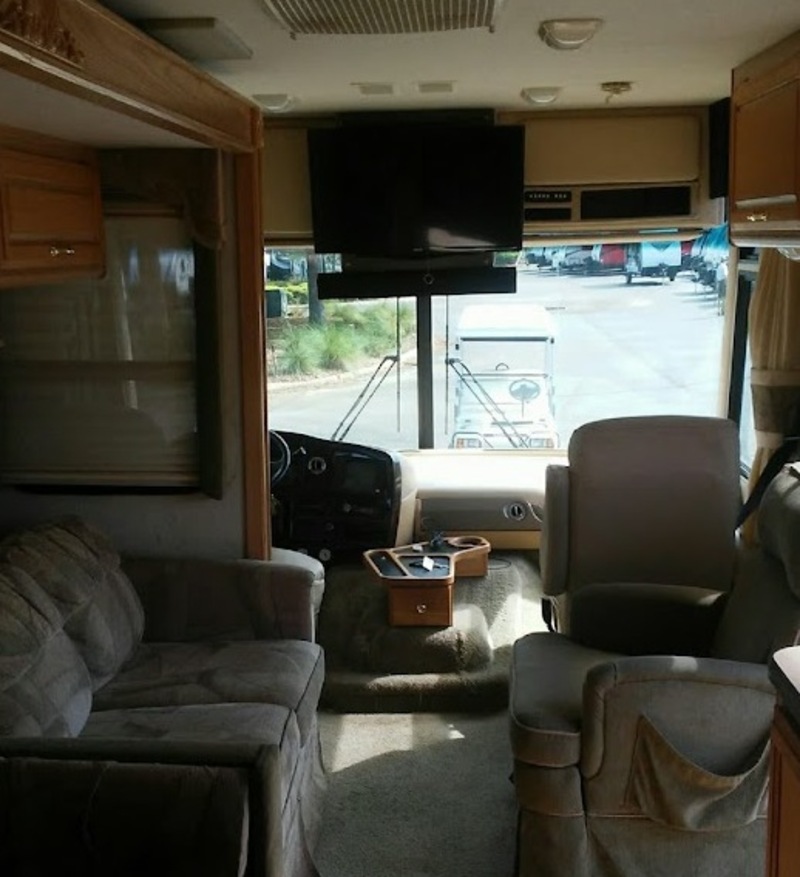
Planning Our DIY RV Cabinet Project
I gave myself a week to mourn and plan the project. I’m decent with tools, but my wife’s nephew is the handyman in the family. I told him my idea for the DIY RV cabinet pet memorial, and we worked together on the project. I grabbed my tool kit and unscrewed the green border. I found that the RV cabinet was made of plywood and used wood braces to support the TV mount’s weight. Whoever put this in must have been a professional or knew what they were doing.
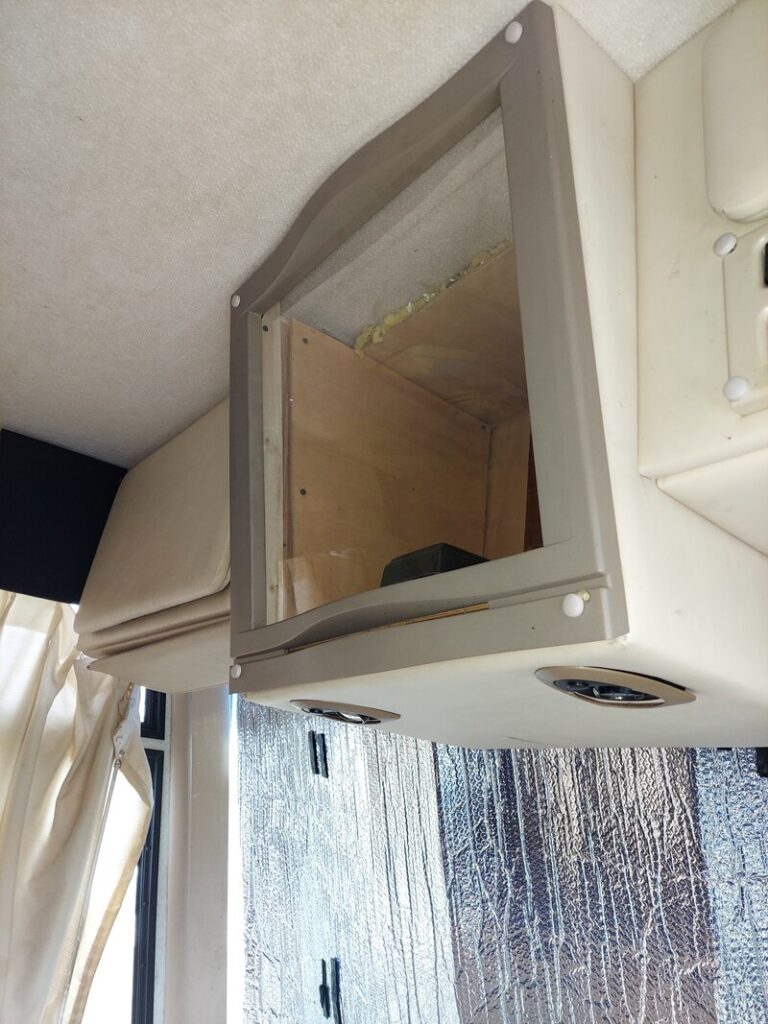
The plywood face board had 1×2 lumber boards bracing it on the front and back. Most of the screws came out well with my electric drill. However, once I opened it up, it was one of those good news/bad news situations.
During the Classic Era (1971-1989) and Neo-Classic Era (1990-2007), the RV cabinets and furniture still used natural wood. Lightweight substitutes were just coming out right before the 2008 financial crash. One of the reasons I bought my 2001 Pace Arrow was that it had natural wood and was in excellent shape. Lightweight materials have their advantages, but Jim and I know how to work with plywood better than Medium Density Fiberboard (MDF).
Plyboard is layered natural wood glued together in multiple layers. MDF uses wood particles mixed together with a composite compound to form the board. The fiberboard is stronger and weighs less than real wood. The smooth outer layer of MDF holds paint, but if you want a natural wood look, it requires an artificial adhesive paper layer.
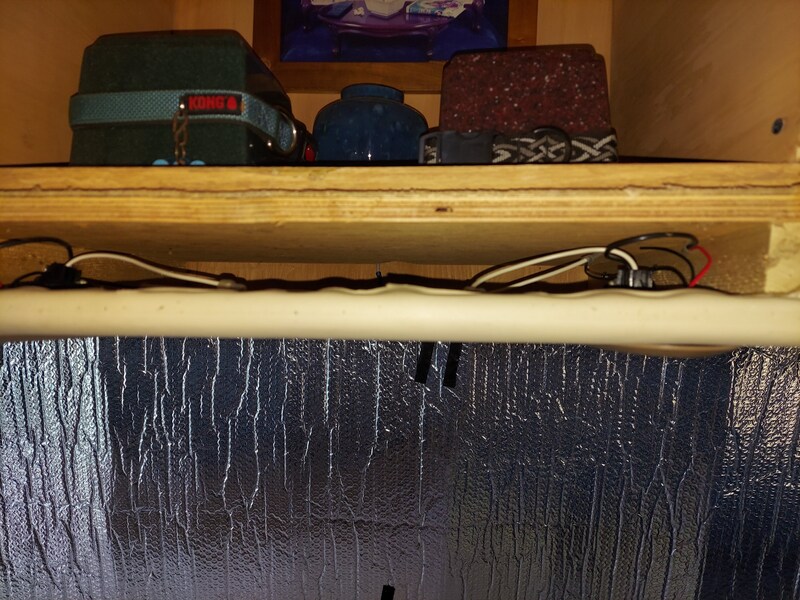
The bad part was all of the wires. The Class A motorhome came with a Winegard satellite dish and TV antenna. The media components wire into the storage compartment above the co-pilot’s section. Mari and I decided to stick with internet-based media services, so the dish and antenna aren’t helpful. Above the fiberglass batt insulation is the roof underside.
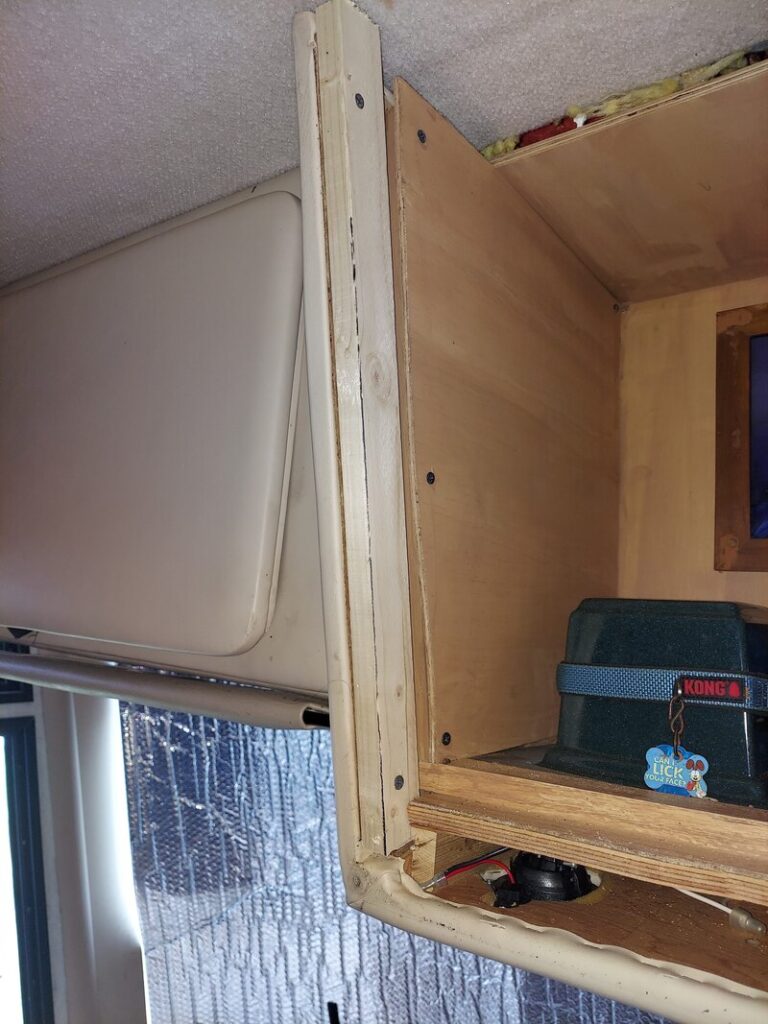
The first thing I thought of was moisture. Then, since the loose fiberglass batt insulation and the roof’s right there, I thought about condensation or possible leaks. So I grabbed a flashlight and conducted a visual inspection. Luckily, I didn’t find anything, but this DIY RV cabinet will need to be opened 2-3 times a year during preventive maintenance routines.
I cut the satellite wire and put wire nuts on the exposed ends for safety. I also took some white medical tape and made an impromptu flag on the wire identifying each one if I ever need to reconnect it in the future. In the RV world, the phrase “you never know” is more universally true than the word “never.”
Once my nephew Jim and I knew what we were looking at, we did our measurements and created our hardware store shopping list. Then, realizing some of it was a little unrealistic, we remade the list in a manageable way (we couldn’t justify that pneumatic auto-nailer we’ve always wanted).
Here’s our shopping list:
- ¼ inch thick plywood board cut to size for a ceiling, back, and side panels.
- A 1×2 beam that we can cut into multiple pieces for bracing.
- A plexiglass sheet we can attach to the green border to view inside.
- A foam rubber interlocking tile for gyms or playrooms.
- A multipack of self-tapping wood screws of various lengths.
- A small container of wood stain custom matched to our wood interior.
- A paintbrush made for wood stain.
- A paint pan to pour the stain into while working.
- LED lights with a wireless remote.
- Four short self-tapping screws and wide washers.
- An electric screwdriver
- A retractable utility knife
- A jigsaw and fine wood blades (check out RV Camping Magazine’s June 2021 article on Electric Trucks to learn why the new brushless motors make the new cordless power tools so much better).
- Safety goggles
- Mike’s favorite orange nitrile disposable gloves
I try and use local business as much as possible, but sometimes the big box stores have those products or services the little guys don’t. I needed the plywood cut with a minimal margin of error. That saw mechanism they use is very accurate. While I’d love to buy a saw table, I know Mari would prefer to see that money spent on her wishlist.
Getting to Work

When we installed the top, side, and back pieces, my nephew and I reused some of the original 1×2 brace pieces. The top and back boards fit in place very well. The sidewalls of the cabinet already had plywood in place. Still, we both agreed adding matching wood over the original boards would hide the existing mounting brackets and make the sideboard look better.
Finding the Right Stain Color for Our DIY RV Cabinets
At the hardware store, I looked at the pre-mixed stains. They didn’t seem right, so I grabbed a brochure with the various stain samples. I’m usually wrong when I guess, and this cabinet has to look right. While my nephew was putting things together, Mari and I discussed the finer points of stain colors. We went back and forth between three different stains and finally agreed on one. We finally decided on one, and I ran back to the hardware store to get it mixed.
If you want to find the original wood stain of your coach, you can contact the RV manufacturer. We have a label inside one of our rear closet doors with the stain code, but the manufacturer can look it up for you if you can’t find it. Manufacturers may have the stain available for current models and those a few years old. Otherwise, the company may mix up a can or two for you once they know the code and ship it to you directly.
For my specific situation, if I was rebuilding a whole section, the cost might be worth it, but Behr’s Golden Beige was close enough for our DIY RV cabinet project. We only needed their smallest can anyway. Our front overhead cabinets have an off-white padded exterior, so we’re not putting different woods next to each other.
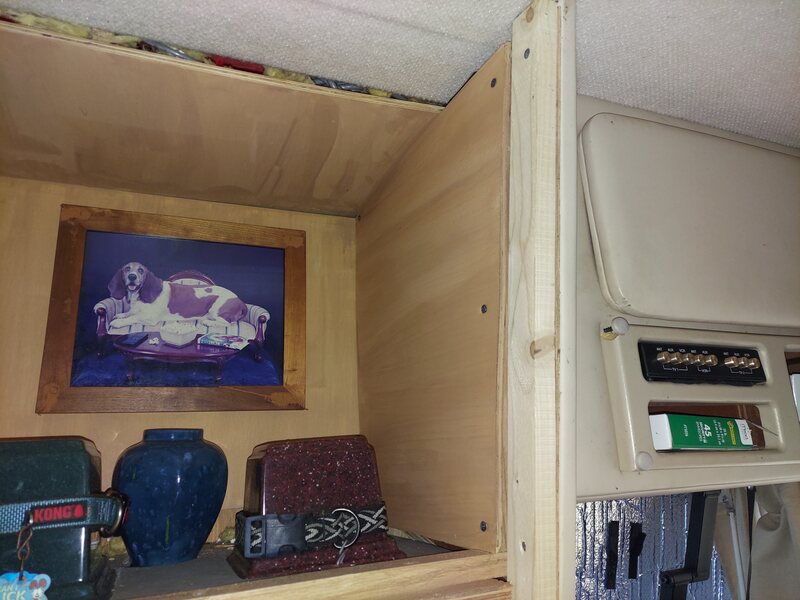
I Proved Mike Right…Insert Frustration
When I returned home, the cabinet was finished and ready for stain. I covered my dashboard with a drop cloth, pulled on Mike’s favorite disposable gloves, and was about to start working on staining the cabinet when I realized something.
At this point, I have to let you in on an inside joke Mike and I have. When working with the sewer hose, Mike and I have different philosophies. He likes using disposable gloves, while I use a pair of thick rubber gloves. One’s not better than the other, they’re just different philosophies. I knew I’d get messy for this project, so I picked up a small package of Gloveworks heavy-duty orange nitrile disposable gloves at the hardware store.
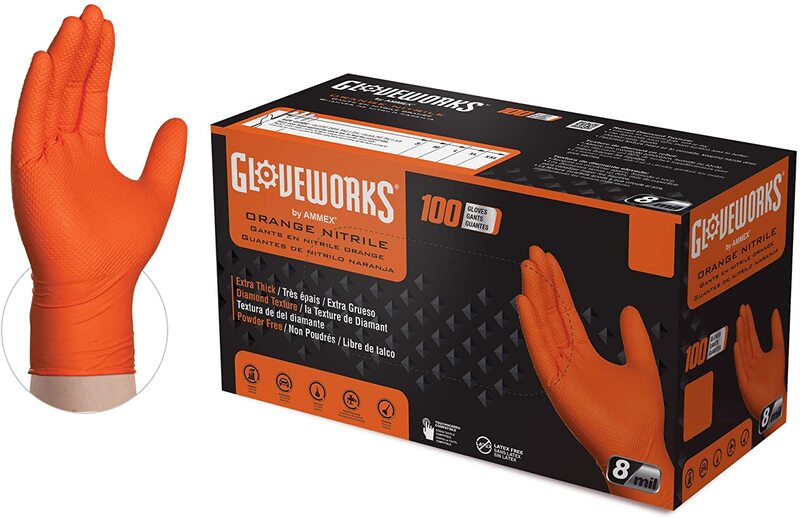
Once I had the gloves on, I stopped, shook my head, and proceeded to use some not-nice frustrating words. I had just proven Mike’s point on why disposable gloves are better than my thick rubber gloves. You can use them for other things like DIY RV cabinet projects.
Even in the worst of times, you have to find a way to laugh. I can already picture Mike, Susan, Marianne, and I laughing about this around a campfire someday.
Keeping the Monuments in Place
Keeping the monuments in place is critical. We thought about adding a ¾ inch piece of plywood to use as a shelf. I went so far as buying a Dremel tool and digging down into the first two layers of plywood as a way to hold Anubis’ Monument from sliding around. Then, one night I put his monument on the bottom with our other dogs’ urns to move them out of the way.
I opened up the lights I bought and placed them behind the urns. I realized the urns looked great on the bottom. The ambient light looked better, lighting up the whole DIY RV cabinet. So after showing Marianne, we scrapped the shelf idea.
I still needed something to keep the monuments in place, absorb road vibration, and not distract the eye. My nephew Jim had foam rubber tiles in his garage. They’ve been sitting there so long; I figured why not. I talked to him about it, and he thought it was a great idea. Double-stick tape with a foam layer in between would add additional vibration absorption underneath the monuments for added security.
I cut the foam to size with my utility knife and then traced the monuments. Instead of cutting straight down, I angled my cuts diagonally, making the bottom slightly smaller than the top. By cutting the foam rubber in this fashion, the foam rubber would hold the stone urns tighter.
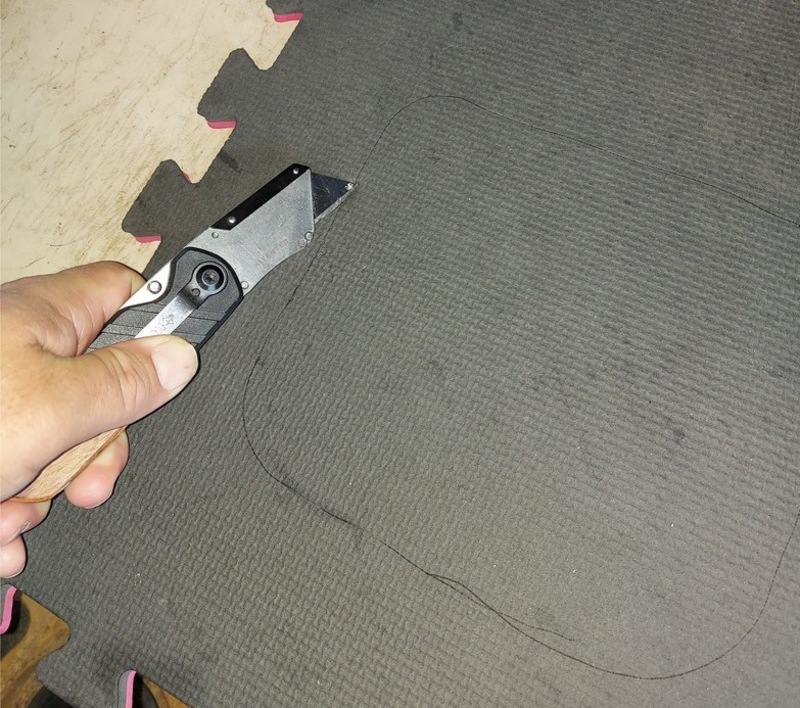
At first, I thought I needed two layers of foam rubber but found that one was enough. However, I had to recut one of the holes because the monument was too close to the wooden sidewall. After the correction, I used the scrap to fill in the space, keeping the urn from sliding against the wall.
Instead of cutting a new piece, I corrected the mistake and cut a bit from the original positive. I made it bigger than what was required, so it would put pressure on the monument, forcing it away from the back wall.
Lighting Up Our DIY RV Cabinets
Marianne and I knew the completed cabinet would be dark, so we had to add lights. In my defaulted 20th century mentality, I was trying to figure out how to wire up lighting and add a switch outside the cabinet. Then I saw wireless LED lights with a remote (don’t worry, Millenials, my daughter took care of the “dinosaur” comments).
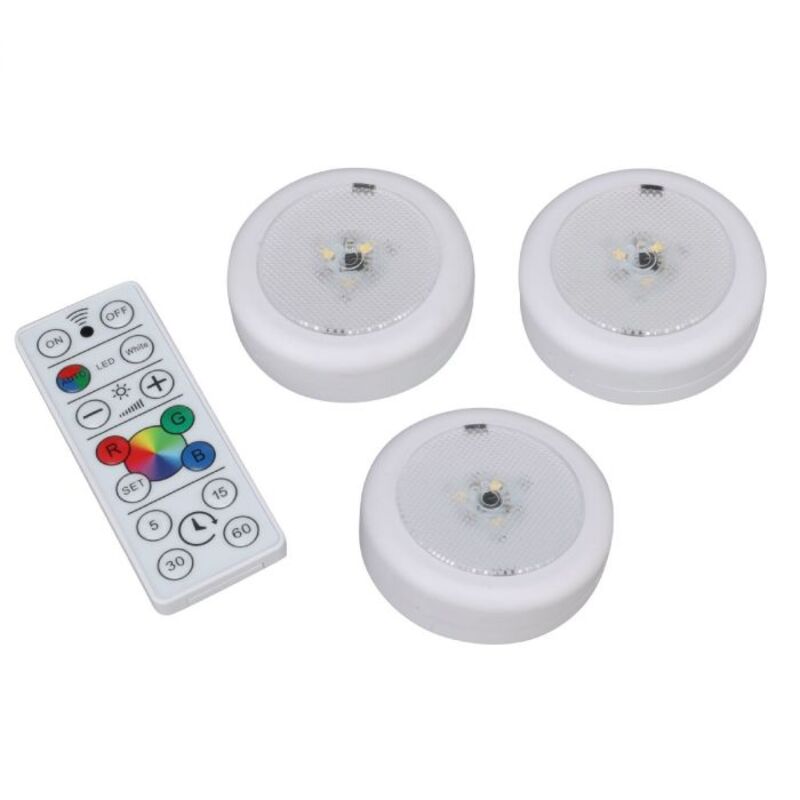
I taped two LED lights behind the front urns to give the cabinet an ambient light effect. When I tested it out, the wood and stain were bright enough to reflect light providing the space with the right look. The lights change from white, blue, green, and red to add effects. The wireless remote allows us to change the brightness and has timer options. When I conducted the light test, it was perfect.
Hanging the Picture Frame
I have a picture of my parent’s basset hound that I wanted to add. The best way to secure it was to screw it in with self-tapping screws. I then added some similar colored stained wood putty to hide the screws. Unfortunately, I learned the hard way to be careful when screwing the frame into the back wall. The frame cracked because I tightened the screws too much. I slathered on the putty to cover the cracks and lightly sanded off the excess when it dried.
Installing the Plexiglass and Border
Fleetwood placed an olive green border around the TV cabinet. We decided to keep it since it works with the original interior design. Mari and I first thought of adding glass doors. After thinking about road vibrations and the various other what-ifs, we decided to use a solid piece of plexiglass. If something comes loose, the plexiglass won’t break, and we don’t have flying objects coming at us.
Before running out to the hardware store, I checked my handy-dandy hardware junk drawer. I happen to have four small self-tapping screws and 1 ½ inch washers from a previous project. To prevent rattling, I added strips of foil duct tape I had laying around to seal up each side. When you can use stuff from the junk drawer, that’s a win.
Plexiglass comes with a removable film on both sides. I removed the outer layer when I placed the piece on the border. Once I had it screwed down, I then removed the inner film. Since my nephew and I removed some of the original braces, we cut additional 1×2 lumber brace pieces. We attached them to the sidewalls of the DIY RV cabinet to push out the green border.
Our DIY RV Cabinet Memorial Display
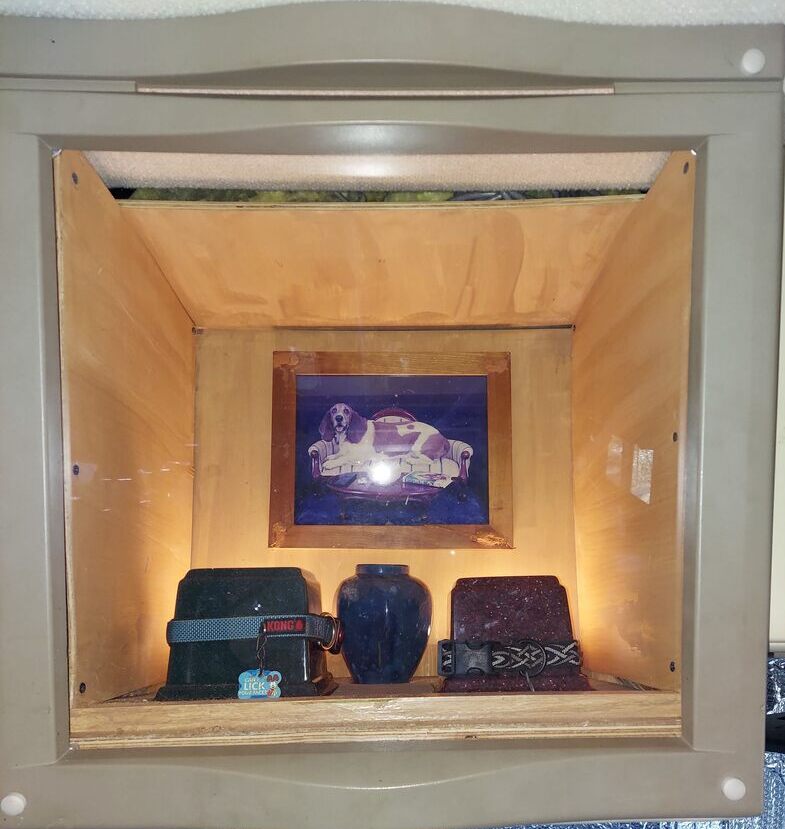
Anubis Ra is the green monument. Bear (or Bearthalamu J when he was in trouble), our Chow/Shepherd mix who came before our current pack, is the red one. The circular blue one in the rear was my mother-in-law’s dog RC, named after the RCA Victor Record Label Mascot (a mixed-breed terrier). Finally, the photo is my parent’s French Basset Hound Snoopy.
Our Whippet mix Keisha and Rotweiller/Beagle Akiva are still with us. Even though science says otherwise, Mari and I like to believe that because dogs have such a pure soul, their spirits use up their bodies faster than humans. Once they cross the Rainbow Bridge, they report back to the Supreme Intelligence Who Created The Multiverse (many call it G-D) and let It know how we’re behaving down here on Earth.
It goes against organized religion, but it helps us cope with our loss and find meaning in the infinitely complex reality we all live. When early man and the wolf first formed that symbiotic bond, I wonder how quickly man became a sucker for those eyes, that “pet me” pawing, and other behaviors that ultimately make you give up half of your meal?

Now all of them have a place of honor that befits the love, loyalty, and everything that made our lives better because they were in it. So whether I’m driving for our next RV adventure or working in my co-pilot RV workspace, all I need to do is look up at my DIY RV cabinet pet memorial, and there’s my Nubie Du.
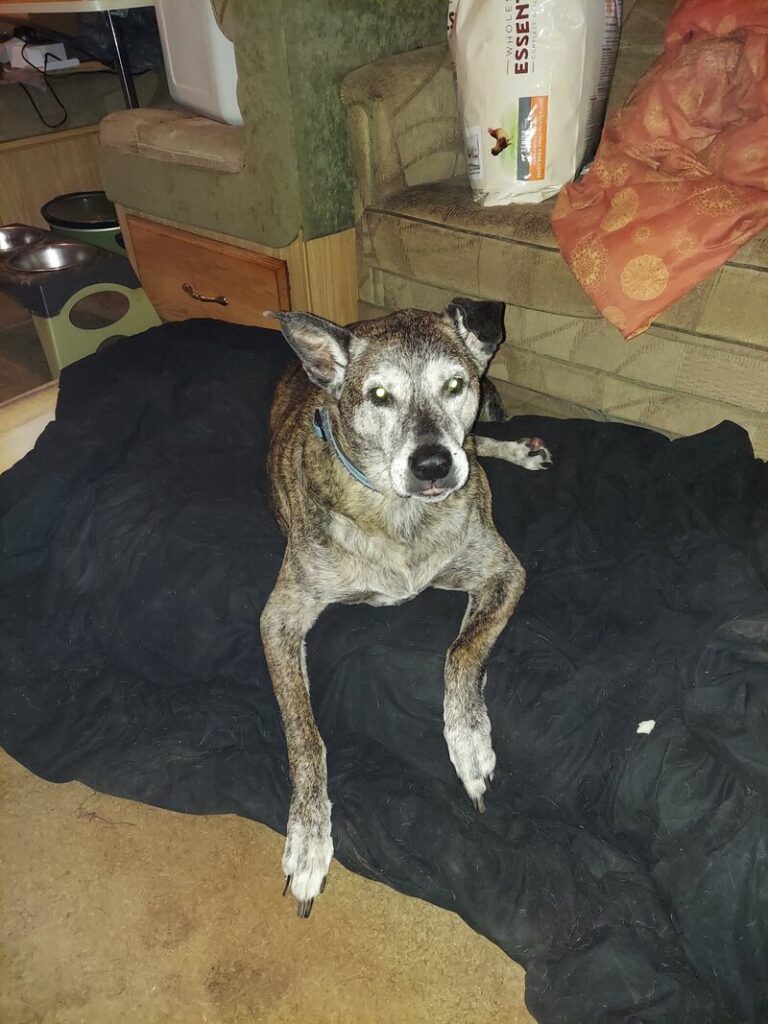
Related Reading:
Best RV Shower Doors for Your Camper
5 Best RV Slide Out Mechanisms Today
How to Repair Cracked RV Graphic Decals
Are Old RVs Worth Buying?
How to Remove, Repair or Replace RV Interior Walls
Brian Newman – Author and Full Time RVer
Although he’s from Motown, Brian Newman is a legacy RVer that grew up on I-75. He, and his wife have enjoyed the full-time RV lifestyle since 2017.
Like John Madden, he hasn’t “worked” in years because he gets to write about his passion. When he’s not working, he supports his daughter’s dog rescue efforts and disability causes.
